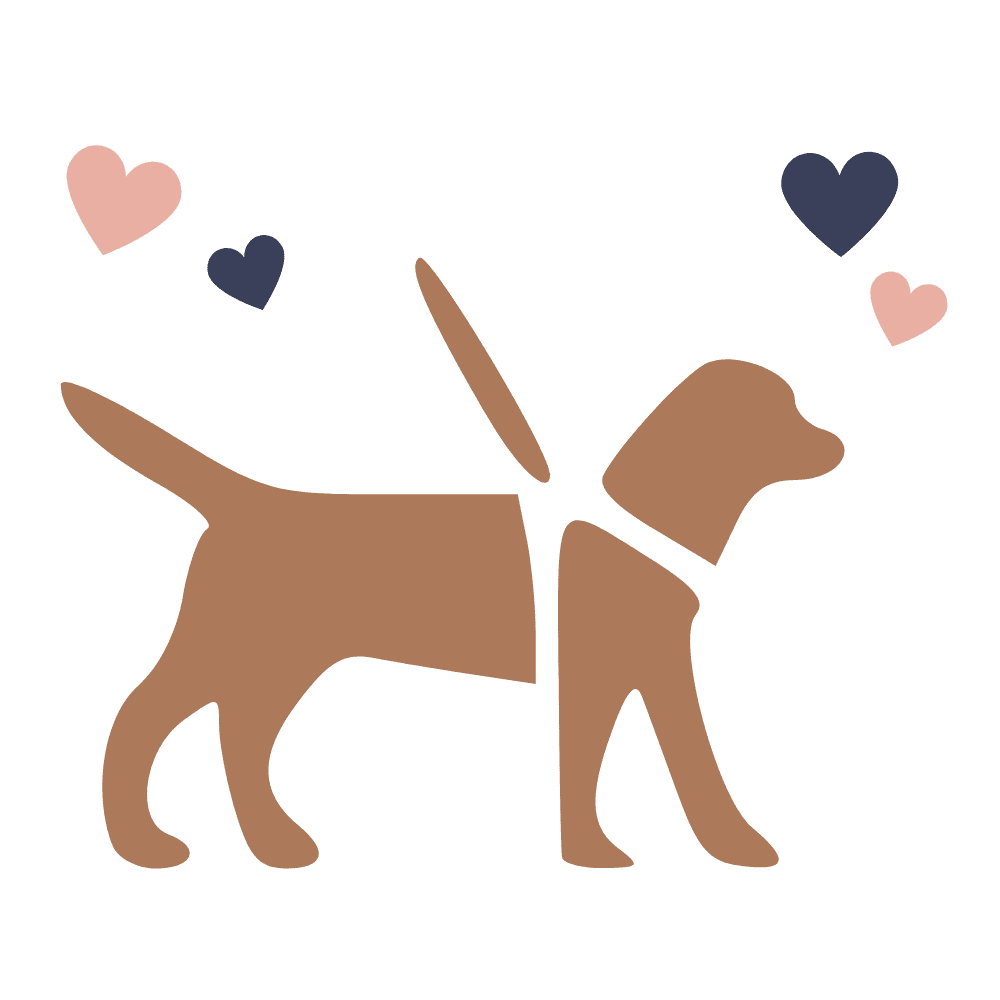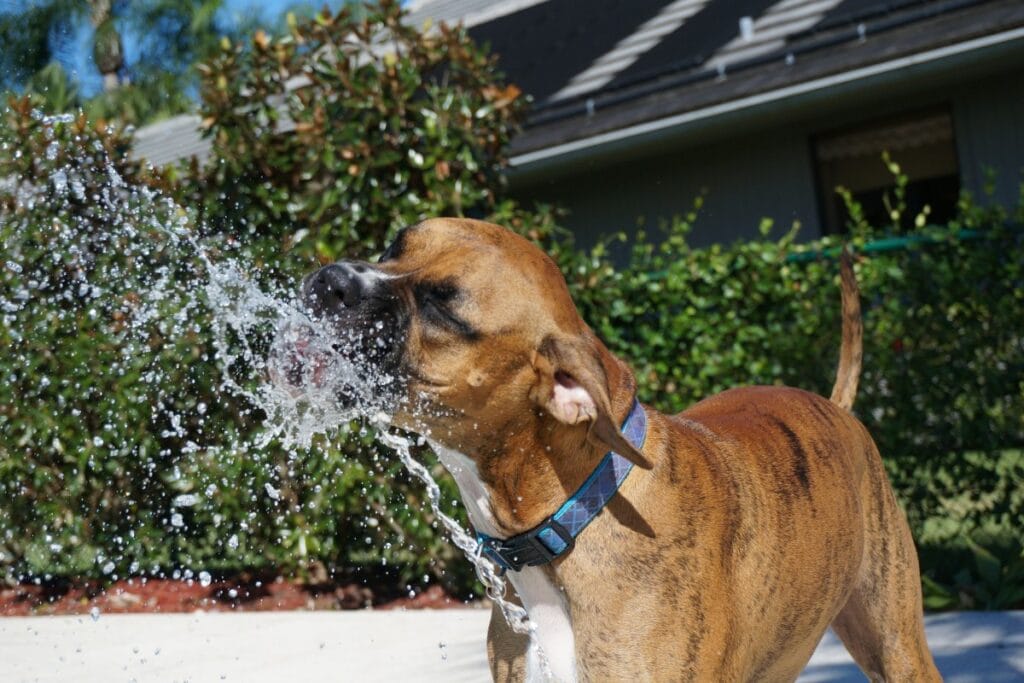
Every walk with your dog (or those of your clients if you walk dogs professionally) should feel refreshing and safe, but when temperatures rise or exercise intensifies, the need to keep your dog hydrated becomes essential for their wellbeing.
Dogs depend entirely on us to recognize their hydration needs and respond appropriately—especially during active walks when dehydration risks multiply with every step.
A properly hydrated dog bounds along with energy to spare and bright, alert eyes.
When that crucial balance tips, subtle warning signs like excessive panting, dry gums, or sudden lethargy can escalate quickly into dangerous territory.
Many pet owners discover too late how rapidly their dogs can overheat or become dehydrated.
Clean, fresh water does far more than quench thirst—it regulates body temperature, lubricates joints, supports kidney function, and maintains healthy digestion.
Professional dog walkers and veterinarians universally agree that proactive hydration management is fundamental to canine health and safety.
This comprehensive guide provides you with veterinary-approved strategies, practical tools, and insights to keep your dog hydrated during every adventure.
You’ll discover how to recognize early dehydration signs, choose the right portable gear, and adapt your approach for different weather conditions and dog breeds.
Key Takeaway: Dogs need approximately 1 ounce of water per pound of body weight daily, with significantly more required during exercise and warm weather. Early intervention when you spot dehydration signs can prevent emergency veterinary situations.
- Why It's Essential to Keep Your Dog Hydrated During Walks
- Recognizing Early Signs Your Dog Needs Water
- Proven Strategies to Keep Your Dog Hydrated on Walks
- Year-Round Hydration: Beyond Summer Safety
- Managing Hydration for Multiple Dogs During Group Walks
- Emergency Response: What to Do When Dehydration Occurs
- FAQs: Keeping Your Dog Hydrated During Walks
- Wrap-up: Keeping Your Dog Hydrated During Walks
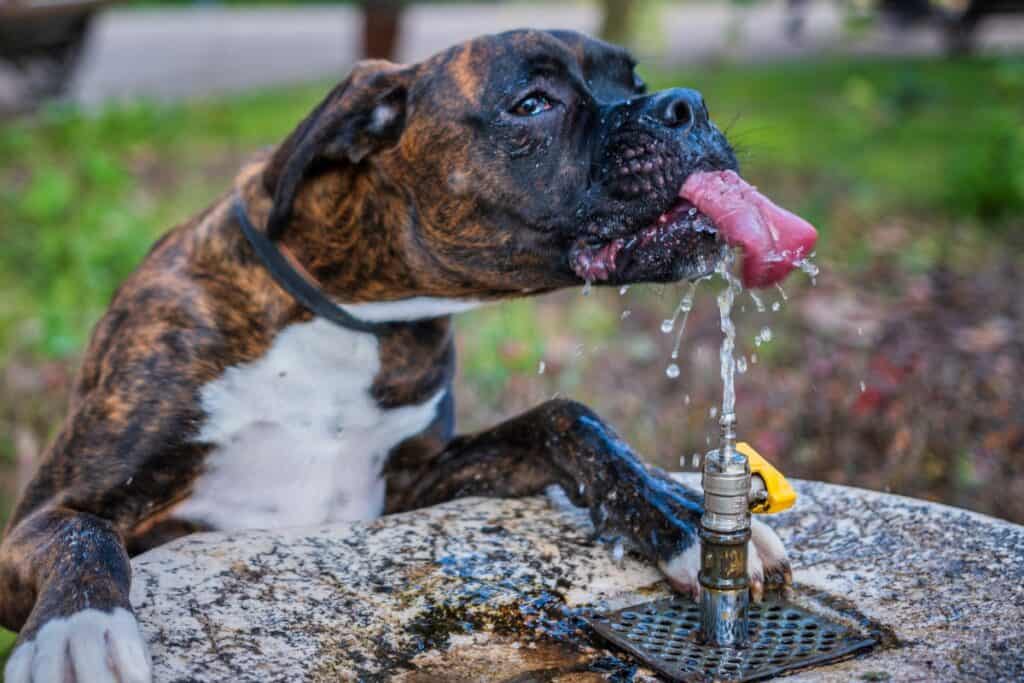
Why It’s Essential to Keep Your Dog Hydrated During Walks
Hydration forms the foundation of every healthy, enjoyable walk.
When you successfully keep your dog hydrated, you’re supporting complex biological systems that enable your pet to run, explore, and thrive during outdoor adventures.
Water Powers Critical Body Functions
Water drives virtually every process in your dog’s body. It transports nutrients from meals to individual cells, maintains proper blood circulation, and lubricates joints for smooth movement.
During walks, each step generates internal heat and burns energy stores.
Without adequate water, dogs struggle to regulate body temperature effectively, and muscle fatigue accelerates.
According to veterinary physiologists, proper hydration supports smooth digestion and backs up kidney health by efficiently flushing waste products that accumulate during physical activity.
Heat Regulation Becomes Critical During Exercise
Unlike humans, dogs have limited cooling mechanisms—they primarily regulate temperature through panting and minimal sweating through paw pads.
Exercise combined with warm weather dramatically increases dehydration and overheating risks.
Following the essential heat safety tips and recommendations throughout this post can help prevent dangerous situations.
Temperature Safety Guidelines:
- 77-82°F: Requires increased vigilance and more frequent water breaks
- Above 82°F: Significantly dangerous for most dogs, especially during exercise
- Above 89°F: High heat stroke risk—consider postponing walks
When dogs cannot access sufficient water, their body temperature can rise dangerously, potentially leading to heat exhaustion or life-threatening heat stroke.
Understanding these risks is a fundamental part of weather safety for responsible dog owners.
Early signs often appear gradually: increased panting, slower pace, or seeking shade.
Supporting Joint Health and Sustained Energy
Think about your dog’s excitement at the start of each walk. Proper hydration maintains that enthusiasm throughout your journey.
Water cushions cartilage, reduces joint friction, and keeps muscles functioning optimally.
Well-hydrated dogs demonstrate better endurance, allowing neighborhood strolls and park adventures to last longer while remaining comfortable for your pet.
This connection becomes especially important for active breeds and senior dogs with joint sensitivities.
Keep Your Dog Hydrated to Prevent Health Issues
Dogs experiencing chronic mild dehydration face increased risks of urinary tract infections, kidney problems, and reduced immune function.
During walks, maintaining proper hydration creates a protective buffer against these health setbacks.
Remember: Planning ahead to keep your dog hydrated is always more effective than scrambling to address dehydration after it starts. Making water a non-negotiable part of your walking gear protects your dog’s immediate comfort and long-term health.
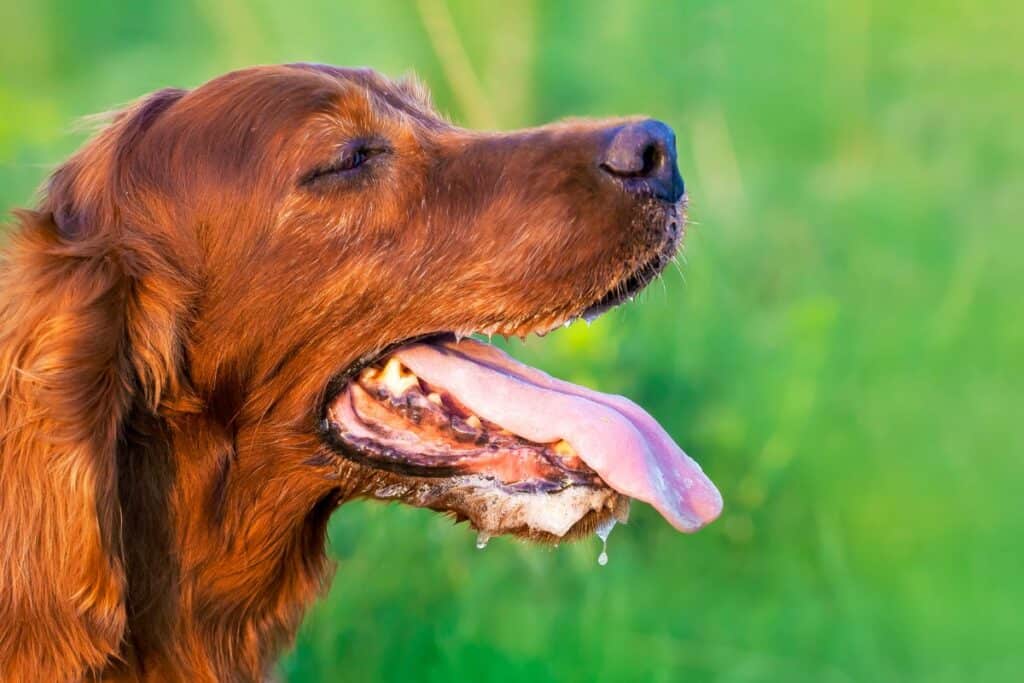
Recognizing Early Signs Your Dog Needs Water
Dogs cannot verbally request water, making it essential for responsible pet owners to recognize subtle behavioral and physical cues indicating hydration needs.
Catching dehydration early prevents minor issues from escalating into veterinary emergencies.
Physical Warning Signs Every Dog Walker Should Monitor
Immediate Alert Signals:
- Excessive panting: Normal cooling versus labored, open-mouth breathing
- Dry or sticky nose and gums: Healthy dogs maintain moist nasal passages and slick gum surfaces
- Thick, sticky saliva: Replaces the normal clear, thin consistency
- Pale or tacky gums: Should appear pink and feel slippery when touched
- Reduced skin elasticity: Perform the “skin tent test” described below
Behavioral Changes to Watch:
- Sluggish movement or stumbling after initial energy
- Decreased interest in surroundings or treats
- Seeking shade or cool surfaces persistently
- Unusual restlessness or confusion
Performing the Skin Tent Test
This simple field test provides immediate hydration assessment.
Gently pinch the loose skin between your dog’s shoulder blades, then release. In well-hydrated dogs, skin snaps back to normal position within one second.
Results interpretation:
- Immediate return: Good hydration status
- 1-2 second delay: Mild dehydration—offer water immediately
- 3+ second delay: Moderate to severe dehydration—seek veterinary attention
Breed-Specific Considerations
Brachycephalic breeds (Pugs, French Bulldogs, English Bulldogs) show dehydration signs more rapidly due to compromised breathing efficiency. These dogs require extra vigilance during any physical activity.
Large and giant breeds may mask early symptoms better than smaller dogs, making regular monitoring even more critical. Senior dogs and puppies dehydrate more quickly than healthy adults, necessitating more frequent water breaks.
When to Take Immediate Action
If your dog displays multiple dehydration signs simultaneously, offer water immediately and move to shade.
Signs requiring immediate veterinary attention include vomiting, diarrhea, complete refusal to drink, or collapse.
Quick intervention when you first notice symptoms often prevents the need for emergency veterinary care and keeps your walking adventures safe and enjoyable.
Check out our Dog Hydration Calculator just below to get an idea how much water your particular dog might need on a walk in a variety of situations.
🐕 Dog Hydration Calculator
Estimate your dog’s water needs during walks
Recommendations for Your Walk
⚠️ Important Disclaimer
This calculator provides estimates only and should not replace professional veterinary advice. Individual dogs may have significantly different hydration needs based on health conditions, medications, and other factors not captured in this tool.
Please consult your veterinarian if you have any questions regarding your dog’s hydration needs during walks and their relationship to your pet’s health. This is especially important for dogs with medical conditions, senior pets, puppies, or breeds prone to breathing difficulties.
Calculation Logic Used:
- Base Formula: 1 ounce per pound of body weight daily, proportioned for walk duration
- Activity Multipliers: Low (1x), Moderate (1.5x), High (2x)
- Weather Multipliers: Cool (1x), Mild (1.2x), Warm (1.5x), Hot (2x)
- Special Considerations: Additional 25-50% for high-risk breeds and age groups
- Safety Buffer: Results include 20% safety margin above calculated minimum needs
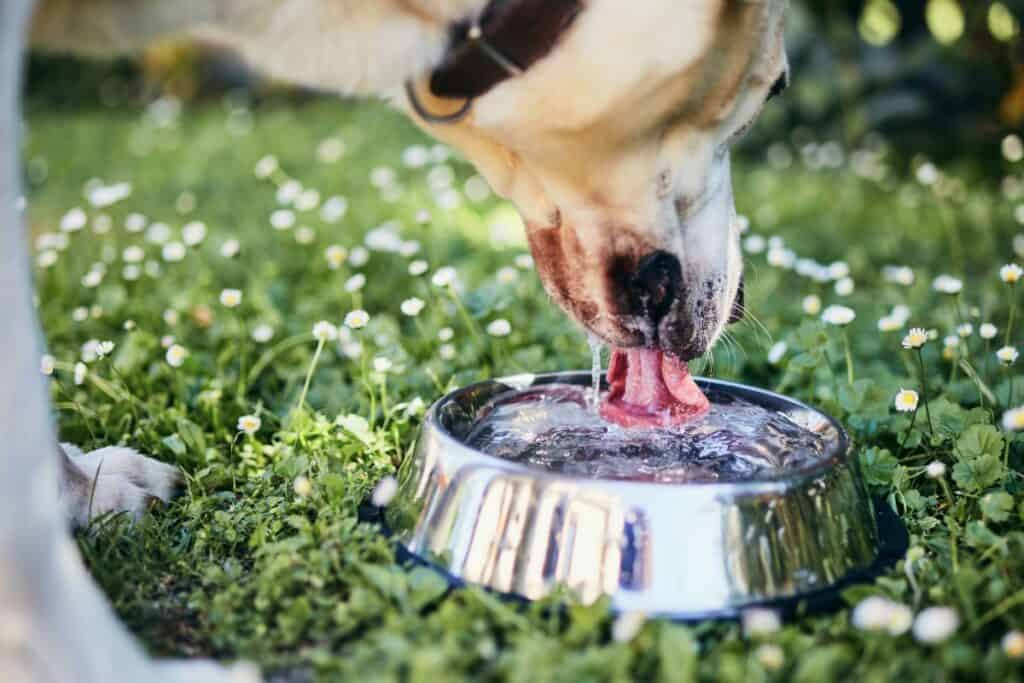
Proven Strategies to Keep Your Dog Hydrated on Walks
Successfully maintaining your dog’s hydration requires the right equipment, smart planning, and creative approaches that make drinking water appealing and accessible throughout your journey.
Choosing the Right Portable Water Equipment
Essential gear selection starts with practical, leak-proof bottles designed specifically for active dogs.
Look for squeeze bottles with pop-up spouts or snap mechanisms that operate easily with one hand while managing leashes.
Collapsible silicone bowls represent excellent space-saving solutions—they fold flat in pockets or clip directly onto leashes, expanding instantly when needed.
For longer adventures or hot weather, insulated carriers keep water refreshingly cool for hours.
Pro tip: Choose bottles with built-in bowls or detachable drinking surfaces to avoid sharing saliva between you and your pet while maintaining convenience.
Smart Scheduling for Water Breaks
Rather than waiting for your dog to show thirst signs, establish proactive break schedules.
Plan water stops every 15-20 minutes during active walks, with more frequent breaks in warm weather or challenging terrain.
Strategic break locations:
- Shaded areas under trees or building overhangs
- Park benches with nearby grass for comfortable resting
- Areas with natural wind flow for additional cooling
Transform water breaks into positive experiences by offering gentle praise, calm petting, or small treats after drinking.
Food-motivated dogs quickly learn to associate hydration with rewards, making future water offerings more successful.
Keep Your Dog Hydrated with High-Moisture Treats
Boost your dog’s water intake through strategic snack selection.
Safe, hydrating treats include watermelon pieces, cucumber slices, strawberries, and seedless apple chunks.
These foods provide both hydration and appealing flavors during walks.
Frozen treat options work especially well in warm weather—try freezing small fruit pieces or low-sodium bone broth in ice cube trays.
The crunchy texture and cooling effect make hydration fun while providing essential fluid intake.
Pre-walk preparation: Mix a few tablespoons of water into your dog’s regular kibble before departing. This simple step increases overall hydration levels before exercise begins.
Making Water More Appealing for Reluctant Drinkers
Some dogs ignore plain water, especially in new environments.
Flavor enhancement becomes your secret weapon to keep your dog hydrated: try adding small amounts of low-sodium bone broth or dog-safe flavor enhancers to make water more appealing.
Experiment with different bowl materials if your dog seems finicky. Some pets prefer stainless steel over plastic, while others respond better to ceramic or glass surfaces.
Moving water often attracts reluctant drinkers—portable pet fountains create appealing movement and sound.
Temperature matters: Many dogs prefer slightly cool water over room temperature, especially during exercise. Insulated bottles maintain optimal temperature longer than standard containers.
Adapting Strategies for Multiple Dogs
When walking several dogs simultaneously, bring extra water and multiple bowls to prevent resource guarding.
Some dogs drink more readily when they observe others drinking, making group hydration sessions effective.
Monitor each dog individually, as hydration needs vary significantly based on size, age, breed, and activity level.
Establish separate drinking areas if any dog shows possessive behavior around water sources.
Now that you understand the essential strategies for keeping your dog hydrated, you might be wondering which specific products deliver the best results.
After extensive homework and use, we’ve curated some of the most effective, highly rated hydration gear currently available on the commercial market that work great and won’t break the bank.
These products turn the strategies you’ve just learned into practical, reliable solutions for every walking scenario.
🐕 Essential Dog Hydration Products for Walks
Curated gear to keep your furry friend happy and hydrated on every adventure
| 🏷️Product | 📂Category | ⭐Features | 🛒Check the price on Amazon |
|---|---|---|---|
|
WRTZ 3 in 1 Water Bottle
|
💧 Water Bottles & Delivery Systems
|
Keeps water ice-cold for 24 hours with vacuum technology, 32oz capacity, dual detachable bowls perfect for multi-dog walks, leak-proof design for mess-free adventures | 🛒 Check Price https://amzn.to/3TA8iQe |
|
Orvis Dog Travel Water Bottle
|
💧 Water Bottles & Delivery Systems
|
Ingenious lid transforms into wide-mouth drinking bowl, hands-free carabiner attachment, water conservation feature prevents waste, stainless steel maintains perfect temperature | 🛒 Check Price https://amzn.to/45Uhx5x |
|
SÄKER Portable Dog Water Bottle
|
💧 Water Bottles & Delivery Systems
|
Ultra-compact collapsible design when empty, 3-in-1 design with quick-release water control, wide neck fits ice cubes, BPA-free and built for active adventures | 🛒 Check Price https://amzn.to/449VtBa |
|
PupFlask Large Dog Water Bottle
|
💧 Water Bottles & Delivery Systems
|
Unique reversible leaf-shaped bowl flips up instantly, 27oz stainless steel construction, zero-waste design with extra-large silicone cup, odorless and eco-friendly materials | 🛒 Check Price https://amzn.to/4egzjlv |
|
Bonza by Leash Boss Collapsible Dog Bowl
|
🥣 Bowls & Feeding Equipment
|
Adventure-ready collapsible design in four sizes, completely free from BPA/PVC/phthalates, dishwasher safe convenience, versatile for both food and water | 🛒 Check Price https://amzn.to/4kOdV9y |
|
Loving Pets Bella Dog Bowls
|
🥣 Bowls & Feeding Equipment
|
Veterinarian-recommended stainless steel with attractive exterior, removable rubber base eliminates spills and noise, dishwasher safe with five colors available | 🛒 Check Price https://amzn.to/4ljzQ8w |
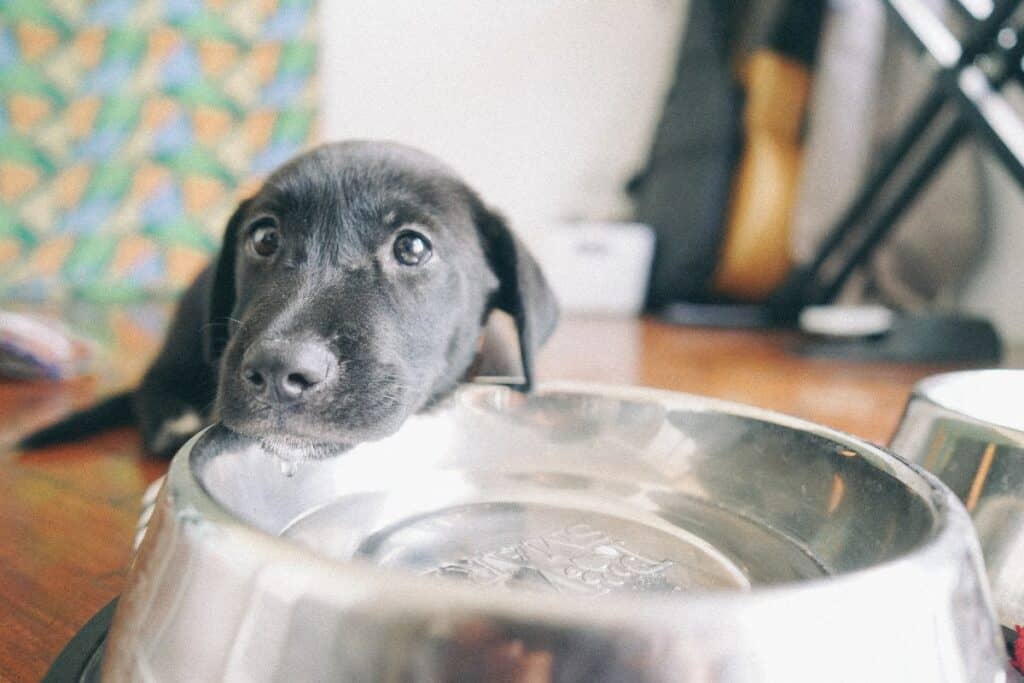
Year-Round Hydration: Beyond Summer Safety
While summer heat receives the most attention, keeping your dog hydrated requires year-round vigilance as seasonal changes create unique challenges that many pet owners overlook.
Winter Hydration Challenges Often Go Unnoticed
Cold weather creates a false sense of security regarding hydration needs, but dogs actually require careful water management during winter months.
Heated indoor environments and dry winter air increase fluid loss through respiration.
Winter-specific risks include:
- Increased caloric needs for temperature regulation boost water requirements
- Snow consumption provides insufficient hydration and may contain harmful substances
- Reduced water bowl accessibility when outdoor sources freeze
- Decreased thirst sensation in cold temperatures
Winter hydration strategies: Ensure indoor water bowls remain fresh and ice-free. For outdoor adventures, pack insulated bottles that prevent freezing and offer water more frequently than your dog’s thirst response might indicate.
Spring and Fall Transition Periods
Seasonal transitions present unique challenges as dogs’ bodies adjust to changing temperatures and activity levels.
Spring’s warming temperatures combined with winter-conditioned dogs create higher dehydration risks during initial warm-weather walks.
Fall’s variable temperatures—cool mornings followed by warm afternoons—require flexible hydration planning.
Pack extra water during these unpredictable weather periods and monitor your dog more closely for temperature-related stress signs.
Hot Weather Makes It Critical to Keep Your Dog Hydrated
Critical summer safety protocols:
- Walk during early morning (before 7 AM) or evening hours (after 7 PM)
- Test pavement temperature with your hand—if too hot for you, it’s dangerous for paw pads
- Carry 50% more water than normal summer calculations suggest
- Seek air conditioning or deep shade for rest breaks every 10-15 minutes
Breed-specific summer considerations: Double hydration monitoring for brachycephalic breeds, thick-coated dogs (Huskies, German Shepherds), and senior pets. These groups struggle more with heat regulation and require more frequent water access.
Recognizing Seasonal Hydration Pattern Changes
Dogs’ water needs fluctuate significantly throughout the year.
Summer requirements may triple normal intake levels, while winter needs often exceed expectations due to dry air and heating systems.
Track seasonal patterns by observing your dog’s normal water consumption at home, then adjust walking hydration accordingly. This baseline understanding helps you recognize when your dog’s needs exceed normal parameters.
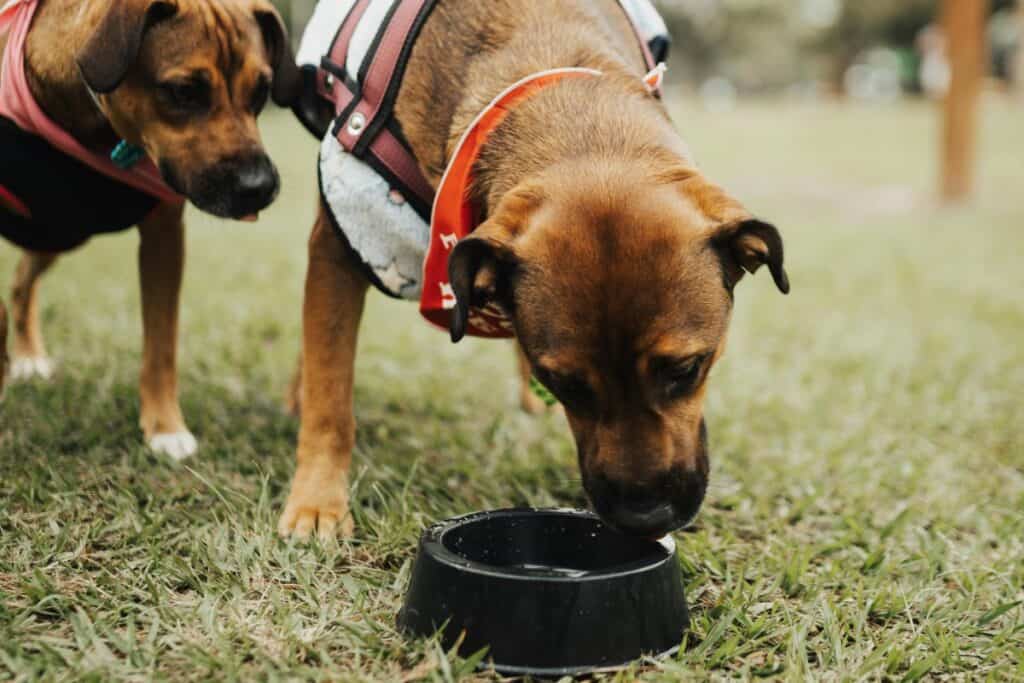
Managing Hydration for Multiple Dogs During Group Walks
Walking several dogs simultaneously multiplies hydration management complexity, requiring strategic planning and individualized attention to keep every pet safely hydrated.
Pack Adequate Water for Every Dog
Calculate water needs individually: A 20-pound dog requires different amounts than an 80-pound dog, especially during exercise.
Bring approximately 4-6 ounces of water per dog for typical 30-60 minute walks, with proportional increases for larger breeds.
Consider each dog’s individual factors—age, health status, coat thickness, and typical activity level—when determining water quantities.
Pack 25% extra water beyond calculated needs to accommodate unexpected circumstances or extended walks.
Equipment solutions for groups: Multiple collapsible bowls prevent resource competition and allow simultaneous hydration. Some walkers prefer bottles with detachable bowls to serve multiple dogs efficiently while maintaining sanitary conditions.
Establishing Consistent Group Water Breaks
Synchronize rest periods rather than responding to individual dogs’ needs, which can create chaos with multiple leashes.
Schedule water breaks every 15-20 minutes, using natural stopping points like intersections or park benches.
Create positive associations by making water breaks social experiences.
Most dogs drink more readily when they observe pack mates drinking, turning hydration into a group activity rather than individual need fulfillment.
Monitoring Individual Dogs Within the Group
Watch for varying dehydration signs across different dogs.
Smaller dogs often show symptoms first, while larger breeds may mask early warning signs longer.
Senior dogs and brachycephalic breeds require extra scrutiny during group activities.
Establish individual baselines by observing each dog’s normal panting patterns, energy levels, and typical recovery times.
This knowledge helps you quickly identify when specific dogs need immediate attention during group walks.
Preventing Resource Guarding Around Water
Some dogs become possessive around water sources, especially when multiple animals are present.
Space water bowls sufficiently apart and supervise initial drinking to ensure every dog gets adequate access.
If resource guarding occurs, create separate hydration stations or rotate dogs through water access individually.
Never allow dominant dogs to prevent others from drinking, as this can quickly create dangerous situations for dehydration-prone pets.
Pro strategy: Bring extra bowls specifically for anxious or submissive dogs who may need private water access away from the group dynamics.
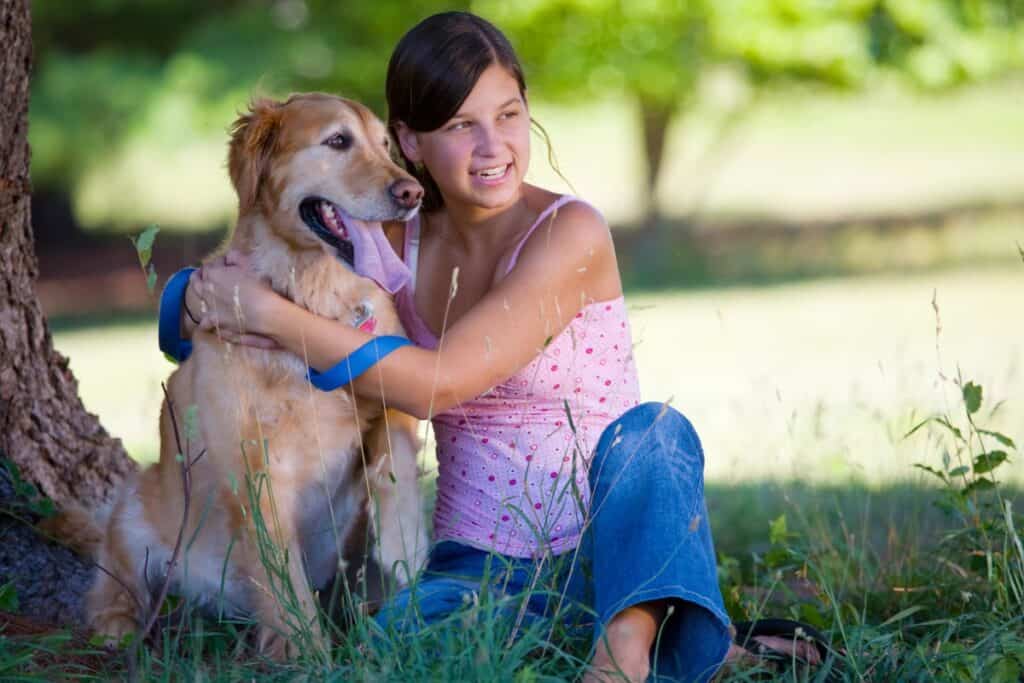
Emergency Response: What to Do When Dehydration Occurs
Despite careful prevention, dehydration emergencies can develop rapidly during walks.
Knowing proper response protocols can save your dog’s life and prevent minor issues from becoming serious medical crises.
Immediate Response for Mild to Moderate Dehydration
Step 1: Move your dog immediately to the coolest available location—deep shade, air conditioning, or even a cool car interior if shade isn’t available.
Step 2: Offer small amounts of water frequently rather than allowing unlimited drinking, which can cause vomiting in dehydrated dogs. Provide 2-4 tablespoons every few minutes for small dogs, 1/4 to 1/2 cup for larger breeds.
Step 3: Apply cool (not cold) water to paw pads, inner thighs, and the base of ears to help lower body temperature. Avoid ice water, which can cause blood vessels to constrict and actually impede cooling.
Recognizing When Professional Help Is Needed
Seek immediate veterinary attention if your dog shows:
- Vomiting or diarrhea accompanying dehydration signs
- Complete refusal to drink water
- Collapse, weakness, or inability to stand
- Gums that appear white, blue, or bright red
- Skin tent test showing 3+ second return time
Call your veterinarian immediately rather than attempting home treatment for severe symptoms.
Many veterinary clinics provide phone consultations to help determine whether immediate emergency care is necessary.
Prevention Strategies for Future Walks
Post-incident analysis helps prevent recurrence. Review what factors contributed to the dehydration episode—was it temperature, activity level, insufficient water breaks, or underlying health issues?
Adjust your hydration protocol based on lessons learned. This might mean carrying more water, taking more frequent breaks, avoiding certain weather conditions, or consulting with your veterinarian about your dog’s individual needs.
Document patterns if dehydration occurs repeatedly, as this information helps veterinarians identify potential underlying health conditions that increase dehydration risk.
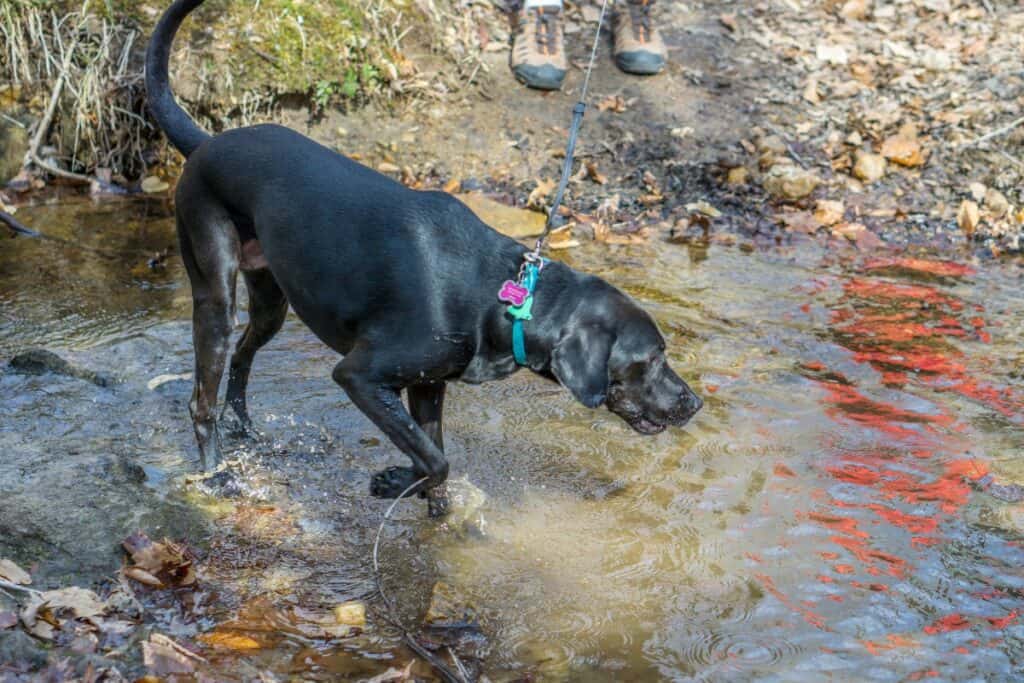
FAQs: Keeping Your Dog Hydrated During Walks
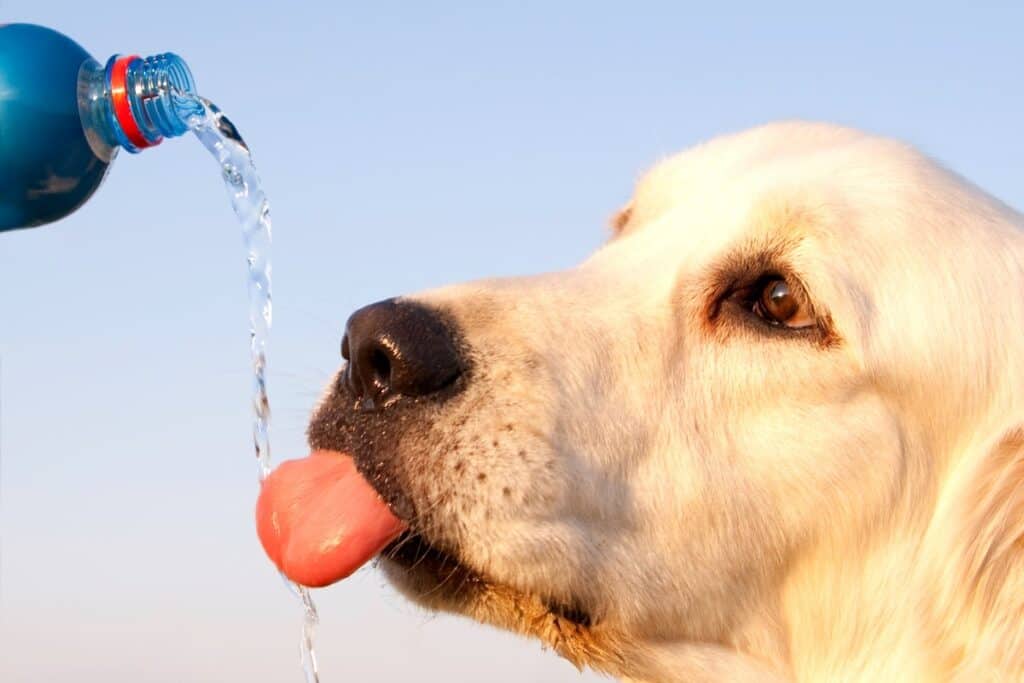
Wrap-up: Keeping Your Dog Hydrated During Walks
Every successful walk depends on maintaining your dog’s proper hydration levels.
By implementing these veterinary-approved strategies—from recognizing early dehydration signs to packing appropriate gear—you create a foundation for safe, enjoyable adventures throughout the year.
Remember the key principles: Dogs need approximately 1 ounce of water per pound of body weight daily, with significantly more required during exercise and warm weather. Proactive hydration management prevents emergency situations and supports your dog’s long-term health and vitality.
Take action today: Evaluate your current walking routine and identify areas for improvement. Whether it’s upgrading your water gear, establishing more frequent break schedules, or learning to recognize your dog’s specific hydration needs, small changes create dramatic improvements in safety and enjoyment.
Your dog depends on you to make informed decisions about their health and safety. By prioritizing hydration during every walk, you’re investing in countless future adventures filled with energy, excitement, and the joy that comes from knowing your furry companion is truly thriving.
Ready to become a hydration expert? Start putting these strategies into action on your next walk and discover how simple it really is to keep your dog hydrated and thriving. When you see that boundless energy and enthusiasm radiating from your pup, you’ll know that every thoughtful preparation you’ve made is paying off in spades.

